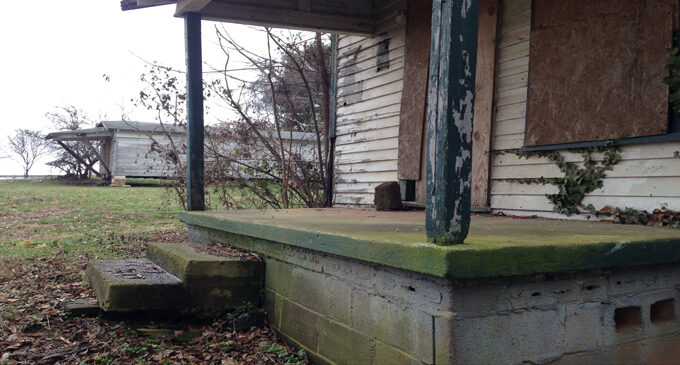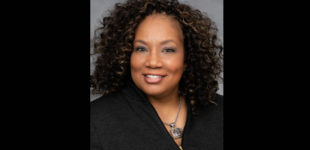Commissioner Woodbury raises questions about Old Salem ARPA spending
One of the shotgun houses located in the Happy Hill Neighborhood.

Funding for Hidden Town Project overlooks adjacent Shotgun House Project
Earlier this month Forsyth County Board of Commissioners approved nearly $400,000 in ARPA (American Rescue Plan Act) funding to Old Salem for restoration to buildings said to be related to the Hidden Town Project, which tells the story of the enslaved Africans who lived and worked in the town of Salem. But the vote didn’t come without some legitimate questions being raised by Commissioner Malishai Woodbury.
Here’s what we know: the American Rescue Plan Act was signed into law in March 2021, to be used to meet pandemic response needs and rebuild a stronger, more equitable economy. Forsyth County received $74,256,322 in ARPA funding and launched a public application process to distribute the funding. The county opened up a public application process in April 2022.
According to public records, Old Salem was seeking $391,875 in funding to refurbish five buildings, The Tavern Museum, Volz Barn, Herbst House, and Blum House, which are said to be directly connected to the Hidden Town Project.
Old Salem’s Hidden Town Project looks to tell the stories of 135 enslaved individuals who lived and worked in the community and made enormous but unsung contributions. Launched in 2016, the mission of the initiative is to research and reveal the history of people of African descent in Salem.
During the commissioners’ briefing session on Thursday, Feb. 23, Commissioner Woodbury, who represents District A, raised questions about how the buildings were chosen and how they relate to the Hidden Town Project.
Michelle Cook, director of development at Old Salem, said with the projects listed in the application, they wanted to focus on buildings that were most closely related to the Hidden Town Project. For example, Cook mentioned Herbst House was the residence of Abraham and Sarah, an enslaved couple. The Bloom House was a print shop where an enslaved man learned the trade at a time when it was prohibited.
Woodbury also brought up the shotgun houses located in the historic Happy Hill Neighborhood that are in need of restoration. “If you look online at information about the Hidden Town project, it is definitely a part of the narrative around what makes up Hidden Town and I think it definitely conveys a more comprehensive picture around what Hidden Town is about,” Woodbury said.
The history of Happy Hill dates back to the 19th century. In October 1836, 18 formerly enslaved and five free African Americans left Salem for Millsberg, Liberia. Seventeen of those emigrants had been owned by Friedrich Schumann, laboring on his plantation on the high grounds south of Salem. In 1872, after the Civil War and emancipation, the Salem Congregation established a neighborhood for freedmen on Schumann’s former plantation. The neighborhood initially was known as Liberia, recalling those who had emigrated. By 1874, the name Happy Hill was used for the neighborhood, which grew steadily between 1880 and 1920.
Around 1920 many shotgun houses began to pop up throughout communities in the South. Relatively inexpensive to construct, the shotgun house is rectangular, one room wide and up to three rooms deep, with a front porch. This architectural style originated from Yorubaland (West Africa) via Haiti to the American South. The word shotgun itself is derived from the Yoruba word “to-gun.” In Yoruba, this word means ‘place of assembly’ or where people gather.
Following the Civil War, these dwellings became a symbol of Black American freedom. In 2017 Triad Cultural Arts, Inc., a nonprofit, community-based, multi-disciplinary cultural arts organization, and the Happy Hill Neighborhood Association, launched the Shotgun House Project to preserve two shotgun houses that are still intact in the 700 block of Humphreys Street. After trying to acquire the shotgun houses for seven years, in 2022 the City of Winston-Salem sold the two homes to the organization for $1.
When making her case for the shotgun houses, several times Woodbury referred to the Hidden Town website, which does highlight their commitment to supporting the Shotgun House Project and the Happy Hill Neighborhood Association. The excerpt from the website reads, “The Hidden Town Project supports the Happy Hill Neighborhood Association and their focus on collaborative energy to foster renewal through recognition of history as well as arts programming and community gardening. Significant efforts led by Triad Cultural Arts seek to preserve culture and architecture through the Shotgun House Project.”
“You all speak of your support, cooperation, wanting to see shotgun houses restored. I’m just wondering why not include the shotgun houses as a part of the restoration buildings,” Woodbury continued. “I applaud Old Salem for what you’re trying to do with Hidden Town, I just think that some consideration around cooperation with people who are in the space that’s invested in the cause would yield us a greater product for the good of the whole.”
Cook said, while they do have a working relationship with the Happy Hill Neighborhood Association and Cheryl Harry, director of Triad Cultural Arts, and the Shotgun House Project, Happy Hill and the shotgun houses are not part of Old Salem and they don’t own the houses.
“The shotgun houses are not part of the historical district. The buildings that you see in the proposal that the county is going to help us with are actually Old Salem properties,” Cook said. “The Happy Hill Neighborhood sits contiguous to Old Salem; again, we are strong partners, we work together, but we don’t own those buildings, we have no connection to those buildings.”
Cook also mentioned that no one from Triad Cultural Arts reached out to them, but she did say they were open to working with TCA and any other organization in the area.
“We’ve worked with every organization in town including Triad Cultural Arts and I want to continue to stress that,” Cook said. “We have representation on our board for the Shotgun House Project and we were never approached about establishing a partnership.”
Terry Taylor, president and CEO of Old Salem, said he understands Woodbury’s questions and the importance of the Shotgun House Project. But he also noted that they have a tough job trying to maintain the 200-year-old buildings within the Historic District.
“We are so concentrated on our own core of the Historic District we don’t sometimes think about giving money to other organizations outside our district. I hear you and I don’t disagree with the importance of shotgun houses, it’s not that at all. We’re just so concentrated on trying to maintain and keep the district the way it looks.”
Woodbury said before she would vote in support of the resolution, she wanted representatives from Old Salem and Triad Cultural Arts to talk about building a stronger relationship moving forward. Before the resolution was tabled for a vote during the County Commissioners’ meeting on March 2, Woodbury thanked Old Salem and Cheryl Harry for meeting and said she would vote in support of the resolution. Woodbury mentioned that the questions she raised helped spark discussions that will help the Hidden Town Project.
“I want to thank Old Salem and Cheryl Harry for meeting to talk about the questions that I raised around the Hidden Town Project and its connections with the Shotgun House Project,” she said. “I think because those questions were raised, we were able to figure out where the miscommunications were and also where we could absolutely grow cooperatively to make Hidden Town a strong product for the citizens of Forsyth County.”











